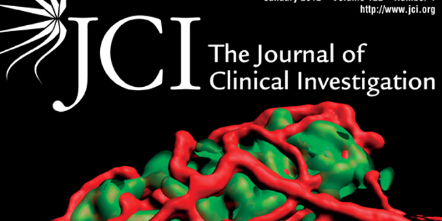
【J CLIN INVEST--IF:13.215】在当地时间4月1日刊发的一期刊物中刊载胞外囊泡文献综述集,其中共有11篇综述文章,涵盖肿瘤、免疫、神经系统、中风及胞外囊泡分离纯化方法讨论等诸多方面。在此 hzangs将英文摘要和链接汇总于此,供大家了解。希望对大家有所帮助。外泌体之家可以为大家提供原文,欢迎大家到论坛索取。
1. Extracellular vesicle isolation andcharacterization: toward clinical application.
胞外囊泡分离和定性:面向临床的应用前瞻。
Abstract:Two broad categories of extracellularvesicles (EVs), exosomes and shed microvesicles (sMVs), which differ in sizedistribution as well as protein and RNA profiles, have been described. EVs areknown to play key roles in cell-cell communication, acting proximally as wellas systemically. This Review discusses the nature of EV subtypes, strategiesfor isolating EVs from both cell-culture media and body fluids, and proceduresfor quantifying EVs. We also discuss proteins selectively enriched in exosomesand sMVs that have the potential for use as markers to discriminate between EVsubtypes, as well as various applications of EVs in clinical diagnosis.
Pubmed:http://www.ncbi.nlm.nih.gov/pubmed/?term=27035807。
2. The biology and function of exosomes incancer.
外泌体在癌症中的生物功能。
Abstract:Humans circulate quadrillions ofexosomes at all times. Exosomes are a class of extracellular vesicles releasedby all cells, with a size range of 40-150 nm and a lipid bilayer membrane.Exosomes contain DNA, RNA, and proteins. Exosomes likely remove excess and/orunnecessary constituents from the cells, functioning like garbage bags,although their precise physiological role remains unknown. Additionally,exosomes may mediate specific cell-to-cell communication and activate signalingpathways in cells they fuse or interact with. Exosomes are detected in thetumor microenvironment, and emerging evidence suggests that they play a role infacilitating tumorigenesis by regulating angiogenesis, immunity, andmetastasis. Circulating exosomes can be used as liquid biopsies and noninvasivebiomarkers for early detection, diagnosis, and treatment of cancer patients.
Pubmed:http://www.ncbi.nlm.nih.gov/pubmed/?term=27035812
3. Versatile roles of extracellularvesicles in cancer.
胞外囊泡在癌症中的多种功能。
Abstract:Numerous studies have shown thatnon-cell-autonomous regulation of cancer cells is an important aspect oftumorigenesis. Cancer cells need to communicate with stromal cells by humoralfactors such as VEGF, FGFs, and Wnt in order to survive. Recently,extracellular vesicles (EVs) have also been shown to be involved in cell-cellcommunication between cancer cells and the surrounding microenvironment and tobe important for the development of cancer. In addition, these EVs containsmall noncoding RNAs, including microRNAs (miRNAs), which contribute to themalignancy of cancer cells. Here, we provide an overview of current research onEVs, especially miRNAs in EVs. We also propose strategies to treat cancers bytargeting EVs around cancer cells.
Pubmed:http://www.ncbi.nlm.nih.gov/pubmed/?term=26974161
4. Dendritic cell-derived exosomes forcancer therapy。
树突状细胞来源的外泌体在癌症治疗中的作用。
Abstract:DC-derived exosomes (Dex) arenanometer-sized membrane vesicles that are secreted by the sentinelantigen-presenting cells of the immune system: DCs. Like DCs, the molecularcomposition of Dex includes surface expression of functional MHC-peptidecomplexes, costimulatory molecules, and other components that interact withimmune cells. Dex have the potential to facilitate immune cell-dependent tumorrejection and have distinct advantages over cell-based immunotherapiesinvolving DCs. Accordingly, Dex-based phase I and II clinical trials have beenconducted in advanced malignancies, showing the feasibility and safety of theapproach, as well as the propensity of these nanovesicles to mediate T and NKcell-based immune responses in patients. This Review will evaluate the interactionsof Dex with immune cells, their clinical progress, and the future of Deximmunotherapy for cancer.
Pubmed:http://www.ncbi.nlm.nih.gov/pubmed/?term=27035813
5. Extracellular vesicles: masters ofintercellular communication and potential clinical interventions.
胞外囊泡:细胞间通讯的大师,临床治疗的潜在靶点.
Abstract:Intercellular signaling viaextracellular vesicles (EVs) is an underappreciated modality of cell-cellcrosstalk that enables cells to convey packages of complex instructions tospecific recipient cells. EVs transmit these instructions through their cargoesof multiple proteins, nucleic acids, and specialized lipids, which are derivedfrom their cells of origin and allow for combinatorial effects upon recipientcells. This Review series brings together the recent progress in ourunderstanding of EV signaling in physiological and pathophysiologicalconditions, highlighting how certain EVs, particularly exosomes, can promote orregulate infections, host immune responses, development, and various diseases -notably cancer. Given the diverse nature of EVs and their abilities toprofoundly modulate host cells, this series puts particular emphasis on theclinical applications of EVs as therapeutics and as diagnostic biomarkers.
Pubmed:http://www.ncbi.nlm.nih.gov/pubmed/?term=27035805
6. Regulation of chronic inflammatory andimmune processes by extracellular vesicles.
胞外囊泡调节慢性炎症和免疫过程。
Abstract:Almost all cell types release extracellular vesicles(EVs), which are derived either from multivesicular bodies or from the plasmamembrane. EVs contain a subset of proteins, lipids, and nucleic acids from thecell from which they are derived. EV factors, particularly small RNAs such asmiRNAs, likely play important roles in cell-to-cell communication both locallyand systemically. Most of the functions associated with EVs are in theregulation of immune responses to pathogens and cancer, as well as inregulating autoimmunity. This Review will focus on the different modes ofimmune regulation, both direct and indirect, by EVs. The therapeutic utility ofEVs for the regulation of immune responses will also be discussed.
Pubmed:http://www.ncbi.nlm.nih.gov/pubmed/?term=27035808。
7. Extracellular vesicles and infectiousdiseases: new complexity to an old story.
胞外囊泡与传染性疾病:老故事的新分支
Abstract:Exosomes and other extracellularmicrovesicles (ExMVs) have important functions in intercellular communicationand regulation. During the course of infection, these vesicles can conveypathogen molecules that serve as antigens or agonists of innate immunereceptors to induce host defense and immunity, or that serve as regulators ofhost defense and mediators of immune evasion. These molecules may includeproteins, nucleic acids, lipids, and carbohydrates. Pathogen molecules may bedisseminated by incorporation into vesicles that are created and shed by hostcells, or they may be incorporated into vesicles shed from microbial cells.Involvement of ExMVs in the induction of immunity and host defense iswidespread among many pathogens, whereas their involvement in immune evasionmechanisms is prominent among pathogens that establish chronic infection and isfound in some that cause acute infection. Because of their immunogenicity andenrichment of pathogen molecules, exosomes may also have potential in vaccinepreparations and as diagnostic markers. Additionally, the ability of exosomesto deliver molecules to recipient cells raises the possibility of their use fordrug/therapy delivery. Thus, ExMVs play a major role in the pathogenesis ofinfection and provide exciting potential for the development of noveldiagnostic and therapeutic approaches.
Pubmed:http://www.ncbi.nlm.nih.gov/pubmed/?term=27035809
8. Exosomes and tumor-mediated immunesuppression.
外泌体和肿瘤介导的免疫抑制。
Abstract:Tumor-derived exosomes (TEX) areharbingers of tumor-induced immune suppression: they carry immunosuppressivemolecules and factors known to interfere with immune cell functions. Bydelivering suppressive cargos consisting of proteins similar to those in parenttumor cells to immune cells, TEX directly or indirectly influence thedevelopment, maturation, and antitumor activities of immune cells. TEX alsodeliver genomic DNA, mRNA, and microRNAs to immune cells, thereby reprogrammingfunctions of responder cells to promote tumor progression. TEX carryingtumor-associated antigens can interfere with antitumor immunotherapies. TEXalso have the potential to serve as noninvasive biomarkers of tumorprogression. In the tumor microenvironment, TEX may be involved in operatingnumerous signaling pathways responsible for the downregulation of antitumorimmunity.
Pubmed:http://www.ncbi.nlm.nih.gov/pubmed/?term=26927673。
9. Extracellular vesicles andintercellular communication within the nervous system.
神经系统中胞外囊泡参与细胞间通讯。
Abstract:Extracellular vesicles (EVs, includingexosomes) are implicated in many aspects of nervous system development andfunction, including regulation of synaptic communication, synaptic strength,and nerve regeneration. They mediate the transfer of packets of information inthe form of nonsecreted proteins and DNA/RNA protected within a membranecompartment. EVs are essential for the packaging and transport of manycell-fate proteins during development as well as many neurotoxic misfoldedproteins during pathogenesis. This form of communication provides anotherdimension of cellular crosstalk, with the ability to assemble a "kit"of directional instructions made up of different molecular entities and addressit to specific recipient cells. This multidimensional form of communication hasspecial significance in the nervous system. How EVs help to orchestrate thewiring of the brain while allowing for plasticity associated with learning andmemory and contribute to regeneration and degeneration are all under investigation.Because they carry specific disease-related RNAs and proteins, practicalapplications of EVs include potential uses as biomarkers and therapeutics. ThisReview describes our current understanding of EVs and serves as a springboardfor future advances, which may reveal new important mechanisms by which EVs incoordinate brain and body function and dysfunction.
Pubmed:http://www.ncbi.nlm.nih.gov/pubmed/?term=27035811。
10. Exosomes in stroke pathogenesis andtherapy.
外泌体与脑中风病理和治疗。
Abstract:Stroke is one of the leading causes ofdeath and disability worldwide. Stroke recovery is orchestrated by a set ofhighly interactive processes that involve the neurovascular unit and neuralstem cells. Emerging data suggest that exosomes play an important role in intercellularcommunication by transferring exosomal protein and RNA cargo between source andtarget cells in the brain. Here, we review these advances and their impact onpromoting coupled brain remodeling processes after stroke. The use of exosomesfor therapeutic applications in stroke is also highlighted.
Pubmed:http://www.ncbi.nlm.nih.gov/pubmed/?term=27035810。
11. Prostasomes as a source of diagnosticbiomarkers for prostate cancer.
前列腺小体:前列腺癌诊断标志物筛选的新方向。
Abstract: New biomarkers are needed to improvethe diagnosis of prostate cancer. Similarly to healthy cells, prostateepithelial cancer cells produce extracellular vesicles (prostasomes) that canbe isolated from seminal fluid, urine, and blood. Prostasomes containubiquitously expressed and prostate-specific membrane and cytosolic proteins,as well as RNA. Both quantitative and qualitative changes in protein, mRNA,long noncoding RNA, and microRNA composition of extracellular vesicles isolatedfrom prostate cancer patients have been reported. In general, however, theidentified extracellular vesicle-associated single-marker molecules orcombinations of marker molecules require confirmation in large cohorts ofpatients to validate their specificity and sensitivity as prostate cancermarkers. Complications include variable factors such as prostate manipulationand urine flux, as well as masking by ubiquitously expressed free molecules andextracellular vesicles from tissues other than the prostate. Herein, we proposethat the most promising methods include comprehensive combinational screeningfor (mutant) RNA in prostasomes that are immunoisolated with antibodiestargeting prostate-specific epitopes.
Pubmed:http://www.ncbi.nlm.nih.gov/pubmed/?term=27035806。
第一篇是关于外泌体分离方法对比的综述。里面涉及到了多种外泌体的分离方法对比和剖析,相信对以后外泌体分离方法的发展会有一定的影响,建议大家都了解一下。如有需要全文而又无法下载的,可以点击阅读原文或者PC端登陆外泌体之家论坛索取,希望这些review对大家有所帮助!
版权归外泌体之家所有,欢迎转载,但请注明出处和原文链接!




